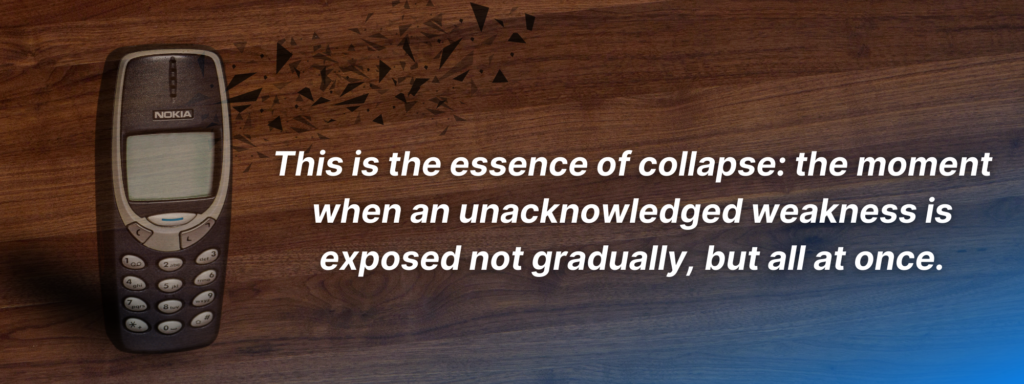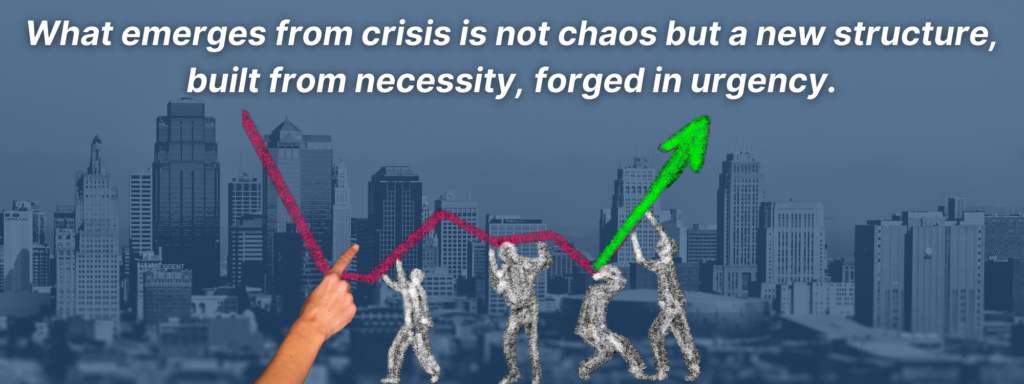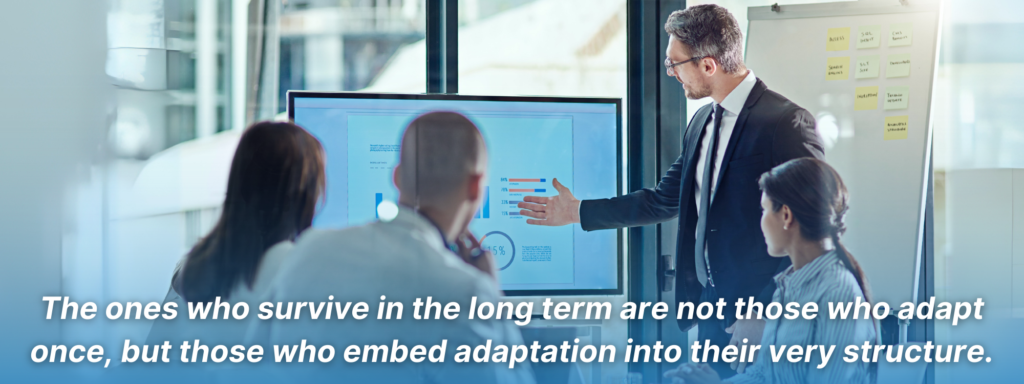The Threshold
The moments before disaster feel unremarkable. Everything appears intact—until it isn’t. A house stands firm before the first crack. A nation appears stable before protest ignites. A company dominates until a single innovation renders it obsolete. Collapse is rarely sudden. It unfolds in slow motion, undetectable until the very moment it is irreversible.
It is a moment of eerie stillness, of misplaced confidence, of believing that because the house still stands, the foundation must be sound. But history suggests otherwise. Collapse is rarely a single event. It is the final, inevitable result of cracks ignored, warnings dismissed, and assumptions held too tightly for too long.
Consider the Ever Given, a 220,000-tonne container ship, wedged sideways in the Suez Canal, blocking one of the world’s most vital arteries of trade. The image was almost comical at first—a lone, colossal vessel brought to a standstill by forces seemingly beyond reason. But what looked like an isolated mishap was, in fact, the manifestation of a global system optimised for efficiency rather than resilience.
Shipping vessels had grown larger, routes had been streamlined, supply chains had been stretched to breaking point, all in pursuit of profit margins measured to fractions of a percent. Then, with a sudden gust of wind and a misjudged manoeuvre, the world was reminded that finely tuned systems can be exquisitely fragile.

This is the essence of collapse: the moment when an unacknowledged weakness is exposed not gradually, but all at once. Nokia, once the titan of mobile technology, found itself in a similar position in 2007. The iPhone was revealed, and the world saw a glimpse of what the future would look like.
But Nokia’s leadership dismissed it as a niche product, an indulgence for tech enthusiasts. They saw only what was in front of them—a comfortable market lead, a strong brand, a dominant position. They failed to see the shifting ground beneath them, the inevitability of touchscreen interfaces, the cultural shift from hardware to software. Like the Ever Given, they were stuck, not by a single catastrophic mistake, but by years of accumulated inertia.
There is always a last clear chance, a moment where a failing system might be steered away from disaster. The Egyptian government had that moment in early 2011, as protests gathered momentum in Tahrir Square. The grievances were well known—corruption, economic hardship, political repression—but the government responded with a mixture of disbelief and half-measures.
Had they recognised the tipping point, had they understood that the force of public unrest had reached a critical mass, the outcome might have been different. Instead, their response oscillated between brutality and concession, ensuring that neither strategy succeeded. The Mubarak regime fell not because it was weak, but because it hesitated when hesitation was fatal.
Collapse, then, is rarely a mystery. It follows a pattern: a period of stability, a failure to adapt, and then a single, defining moment where reality asserts itself. The question is never whether the moment will come. The question is whether those who see it approaching will acknowledge it before it is too late.

The New Order
When an old order collapses, it does not leave behind a vacuum. Something always rushes in to fill the space. The assumption, particularly in structured institutions, is that when a system breaks down, chaos will follow. But history suggests the opposite: in the absence of formal leadership, people organise themselves with surprising speed. The human instinct is not towards anarchy, but towards adaptation.
In August 2010, a tunnel collapsed in a mine in northern Chile, trapping 33 men underground. They had no way to communicate with the surface, no certainty that rescue was even possible, and rations for only a few days. In the first moments of crisis, panic was a natural response. But panic is short-lived. Something else takes over—an instinct deeper than fear. Rather than descending into disorder, the miners formed a structured society.
They appointed a leader, Luis Urzúa, not because he was the most powerful but because he had the clearest sense of strategy. They divided roles—one group focused on rationing food, another on maintaining morale, another on scouting for possible escape routes. In the face of existential uncertainty, they chose order.
This pattern is not unique. During the Blitz in 1940, when German bombs rained down on London, the assumption—reinforced by government fears—was that civilians would break down, that society would fragment. Yet, in practice, the opposite occurred. Ordinary citizens formed improvised rescue teams, coordinated food distribution, and maintained public morale. The government, anticipating mass hysteria, had prepared for an explosion of psychiatric cases. Instead, mental health reports improved. People adapted, because adaptation is not a luxury; it is a necessity.
The same principle explains why some companies survive disruption while others perish. Tesla, in early 2020, found itself facing the same supply chain shortages that crippled other automakers. Traditional manufacturers, paralysed by dependence on standard components, shut down production lines.
Tesla rewrote its software, allowing alternative microchips to be used without redesigning entire systems. The lesson was simple: the moment a system collapses, the ones who move fastest are those who understand that the old rules no longer apply.
What emerges from crisis is not chaos but a new structure, built from necessity, forged in urgency. The ones who succeed are not those who wait for stability to return. They are those who create it from whatever is left.
The Embedded Shift
Survival is often mistaken for success. A system, a company, or a leader weathers a crisis, pulls through, and resumes business as usual. The danger appears to have passed. But survival is not the goal—reinvention is. The difference between those who emerge stronger and those who simply delay their next collapse is whether they recognise that the crisis was not an interruption, but a revelation.
The earthquake did not just level buildings. It shattered certainty. For the people of Christchurch, the world they had known collapsed in seconds. Infrastructure failed. Homes were gone. Lives were upended. Yet the greatest challenge was not the disaster itself—it was what would come after.
The instinctive response—the one that doomed many cities before it—would have been to rebuild exactly what was lost, to reassemble the familiar as if the catastrophe had never happened. But Christchurch did something different. Instead of restoring what had failed, it reimagined what was possible.
City planners designed an urban centre built for resilience, integrating pedestrian zones, earthquake-resistant structures, and smart infrastructure. They treated the disaster not as an obstacle to recovery but as an opportunity to create something better than what had existed before. Their success was not in returning to normal; it was in refusing to.
This is the challenge of transformation: most systems seek to recover, not evolve. The temptation to restore is strong. When Denmark was hit by the 1973 oil crisis, it could have responded as other nations did—with short-term measures to stabilise its economy while maintaining its dependence on fossil fuels.
Instead, it shifted course entirely, investing in renewable energy, redesigning urban spaces around cycling rather than cars, and committing to a long-term vision of energy independence. Half a century later, Denmark leads the world in wind power, not because it survived a crisis but because it used the crisis to reimagine its future.
Contrast this with the companies that failed to make the leap. Blockbuster survived the first few years of competition from Netflix. So did Kodak in the early days of digital photography. Both had the resources, the brand recognition, the market dominance to pivot. But they misunderstood the crisis. They saw it as a challenge to preserve their existing model, rather than an opportunity to discard it. And so, their survival was temporary, an illusion of stability before the inevitable decline.
The lesson is simple but difficult to act on: those who treat a crisis as a chance to reinforce the past will lose to those who use it to create the future. The test of leadership is not whether one can hold things together when the storm hits. It is whether one can see that, once the storm has passed, the landscape has changed forever.

The Lingering Echo
There is no final moment of transformation, no triumphant declaration that the work is done. The greatest mistake any leader, company, or society can make is believing that because they have navigated one crisis, they are prepared for all others. The ones who survive in the long term are not those who adapt once, but those who embed adaptation into their very structure.
LEGO nearly collapsed in the early 2000s. The company had overexpanded, lost its focus, and was drowning in debt. A turnaround strategy saved it—but LEGO did not stop there. It did not treat its near-collapse as a one-time anomaly but as proof that stability itself is the illusion. Instead of merely correcting its course, LEGO institutionalised reinvention. It became more than a toy manufacturer; it evolved into a cultural and digital experience brand, integrating movies, gaming, and interactive storytelling. Today, LEGO thrives not because it survived a crisis but because it made agility a permanent feature of its identity.
Estonia offers another example. After regaining independence from the Soviet Union in the 1990s, it could have focused on restoring its old governmental structures. Instead, it did something radical: it eliminated bureaucracy wherever possible. It built one of the world’s first fully digital governance systems, where 99% of state services can be accessed online, from voting to tax filing. Estonia’s leaders understood that the challenge was not just to rebuild but to create a model that would never again be trapped in old inefficiencies.
This is the real measure of transformation—not whether a system recovers, but whether it becomes unrecognisably better than before. The companies, nations, and leaders that endure are those who never declare their work finished. They do not wait for the next crisis to force adaptation; they design themselves to live in constant evolution.
Because crisis does not operate on a schedule. The next crisis is already moving toward us. Some will brace for impact. Others will break. But the ones who reshape the future won’t just survive—they’ll be unrecognisably new.



